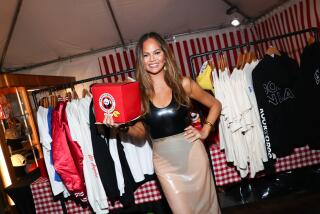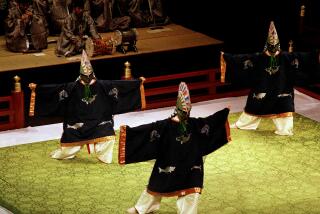Cities Profit From Special Events : Chicago’s Big Picnic Gives New Flavor to Urban Scene
- Share via
CHICAGO — Chemical engineer Kelly Glivar, her hands covered with barbecue sauce and her paper plate filled with spareribs, is contemplating the rest of her afternoon. “Fried cheese, stuffed pizza, cake, ice cream, beer. . . . “
Not far away, Crystal McDade, a high school student, is watching her mother finish a heaping container of fried chicken while making her own list: “Fish, nachos, shrimp, pizza, tacos. . . . “
Dale and Maxine Hall sit with their 4-year-old son and rattle off their menu: “Shrimp, ribs, sushi, egg rolls, cheesecake, turtle soup, pizza. . . . “
The Windy City’s annual gift to gluttony, “A Taste of Chicago,” is under way.
At this eight-day urban food and music fair, which ends Sunday, an estimated 2 million mouths will have a chance to sample food from 86 different restaurants, half of them ethnic. The city’s seventh annual gala for gourmands is one of the largest food festivals in the world.
In an oversized way, Chicago’s big taste also typifies a trend in urban life. Increasingly cities are turning to festivals and sports competitions to boost tourism, draw business back to their downtowns and promote the arts.
Festivals are becoming the way cities celebrate the summer, downtown versions of county fairs and state fairs, often with similar entertainment and food attractions, the same hordes of politicians glad-handing, and the same radio stations blaring from small booths.
But Chicago’s big picnic is unique among American festivals because it turns a profit large enough to pay for the city’s other summertime festivals.
This week as the nation prepares to celebrate the Fourth of July the festival season gets into full swing. There will be more than 3,500 events by year’s end--6,000 if all the county and state fairs are included. In many cities, weekends will be one big municipal party from now until Labor Day.
Detroit attracts tens of thousands to its underused downtown with a Grand Prix race and over 100 riverfront ethnic fairs and concerts during the warmer months. Baltimore pulls hundreds of thousands each summer to its inner-harbor area for performing and visual arts festivals. And Los Angeles offers Street Scene, a weekend fair of food and entertainment that has billed itself as the largest street festival in the country, but which ran into trouble last year when it was marred by violence.
Permanent Festival Grounds
Cleveland is building a festival site on its waterfront--an urban fair grounds. Chicago is searching for a location for a similar permanent festival ground.
The big events in the Windy City, Taste of Chicago and blues, jazz and gospel concerts that will draw more than 3.5 million persons this year, along with evening symphony performances, are centered in Grant Park. The park includes several square miles of athletic fields, formal gardens, fountains and meadows between Lake Michigan and the Loop business district.
It was in Grant Park that war protesters and Chicago police fought during the violent 1968 Democratic National Convention. But this week the sites, sounds and smells are very different, a sign of how times are changing in cities. The blue haze over the streets comes from from cooking, not tear gas, and the smells are mouthwatering, not eyewatering.
The main drive through Grant Park and several cross streets are closed to cars, more than 100 booths fill the barricaded streets, 86 of them cooking and selling food, the rest selling beer, soda pop and souvenirs. The music is a mix of Chicago blues, jazz, and gospel. There are also a one-ring circus, two music stages, three baby diaper-changing stations and hundreds of picnic tables.
Changes People’s Attitude
“Festivals take the urban landscape, which is taken for granted just about every day of the week, and turn it around, making it into something celebratory, giving people a different attitude about their environment,” says Michael T. Marsden, professor of popular culture at Ohio’s Bowling Green State University.
“They are the urban version of the county fair, but they also developed in tandem with gentrification,” adds Marsden. “Taking an inner-city area and turning neighborhoods around, making them into middle-class or upper-middle-class living areas--once that happens, then the idea of taking the downtown and making it into a festival site is a logical extension.”
“Special events are big business now,” says Kathleen McNamara, managing director of Detroit Renaissance, a foundation involved in urban development. “Cities are seeing them as we do . . . as an economic boom. Special events have become a way of life for the people here.”
‘Proven Urban Animator’
“Events are a proven urban animator,” writes Sandy Hillman in Special Events Report, an industry newsletter. “Events have shown they can alter, improve and enhance a city’s image . . . A successful event will generate more and better press than announcing a triple A bond rating or a budget windfall,” says Hillman, an advertising executive and former executive director of Baltimore’s office of Promotion and Tourism.
“Every government should try to have an aspect of bread and circuses,” says Lois Weisberg, Chicago’s director of special events. “It’s good for the city.”
And it is good for corporations. Increasingly big business is investing in event and festival sponsorship. Soft drink and beer companies, fast food chains and cigarette makers, telecommunications marketers and sporting goods manufacturers compete to identify with major urban events. This year, according to the authoritative industry newsletter, corporations will spend $1 billion to sponsor and promote events and festivals in American cities.
“Corporations are finding it is another kind of media,” says Lesa J. Ukman, who monitors the industry as editor of Special Events Report. “Since the (Los Angeles) Olympics, sports marketing and event marketing have become buzz words.”
Wide Range of Sponsors
“This year we have more sponsors than we have (summer) events,” says Weisberg, who lined more than 20 sponsors for this year’s Taste of Chicago. They range from beer companies and Pizza Hut to Northwest Airlines and AT&T.;
Taste of Chicago is the nation’s largest food festival and, according to industry analyst Ukman, it is second in size only to Munich’s Octoberfest, the German city’s annual beer and brat festival.
And for Windy City restaurateurs, it is one of the most coveted events of the year to participate in.
“People would sell their soul just to get a booth here,” says Mayor Washington. “Restaurant owners view this thing like retailers look at space on North Michigan Avenue. One week out here gives them a whole year’s worth of publicity.”
This year, 250 restaurants applied for the 46 available slots. Another 40 booths went to vendors who had participated in previous Taste festivals.
Good for Cheesecake
“We think there is no better way to promote our product than through participating in Taste of Chicago,” says Mark Schulman, president of Eli’s Cheesecake, one of the biggest vendors at the event. “It gets us a lot of attention that you just can’t get through any other vehicle. We might never have been a separate business if it was not for Taste. It created our consumer demand,” adds Schulman, whose father first marketed the cheesecake at his downtown steak house.
“It’s a fabulous way of exposing not only your restaurant name but also your signature item, the product you are known for,” says Stephanie Sherman, sales director for Edwardo’s Pizza. “If you fail, you really fail, but if you succeed you really shine for the next year.”
Chicago’s big picnic is produced and promoted by city hall rather than the local chamber of commerce or a tourism bureau or a private development agency.
“Taste of Chicago doesn’t cost us a dime,” boasts Mayor Harold Washington, once a vocal critic of city festivals.
In fact, Chicago City politicians, who have a reputation for finding fast bucks, have designed the eight-day belly-buster so it also feeds the municipal treasury. Chicago expects to net close to $1 million when sales taxes, sponsor promotion fees, service charges and its 15% share of all revenues are added up this year.
Funds Support ‘Free’ Events
That is believed to be the biggest cash return any city earns from a festival. The profit will be used to pay for other big “free” events, including three days of blues concerts, a two-day gospel sing, a jazz festival and more than 90 neighborhood festivals. A portion of the festival’s income is also donated to the Greater Chicago Food Depository to feed the hungry.
The profit also accounts for Mayor Washington’s change of heart about festivals. In a time of declining federal dollars, static tax revenues and increasing city costs, the event provides a source of income to fund things that are not considered essential city services.
“In the past, the city thought that if a private producer brought in an event . . . and there was national publicity, and the people had a good time, that was just fine as long as the city didn’t lose money,” says Weisberg. “Now we want to keep one big event where we retain the dollars, instead of helping a private company to reap the profit.”
“When these were handled by private promoters, the city used to lose hundreds of thousands of dollars,” says Washington, who calls Taste of Chicago “a great coming-together, a source of pride, and good business for the city.”
Run by Staff of 60
The city has a 60-employee special events office whose primary purpose is the promotion and production of festivals. “We are the biggest in the United States,” says Weisberg, the P.T. Barnum of government here.
But that doesn’t concern the people who crowd into Taste of Chicago. They have other priorities:
“Pizza, hot dog, ice cream, cheesecake, brownie, nachos, root beer, cola . . . ,” says Jamie Dickson, 12, who was sampling the festival for the first time.
“Turkey leg, bratwurst, Vietnamese egg roll, pizza, hot dog, Chinese shish kebab,” says John Sciackitano, 47, who was attending the Taste for the seventh consecutive year. “I like to come here and eat my way around the globe.”
Researcher Wendy Leopold contributed to this article.
More to Read
Sign up for The Wild
We’ll help you find the best places to hike, bike and run, as well as the perfect silent spots for meditation and yoga.
You may occasionally receive promotional content from the Los Angeles Times.






